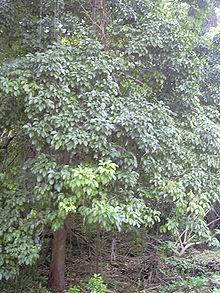- Bischofia javanica
-
Bischofia javanica 
Scientific classification Kingdom: Plantae (unranked): Angiosperms (unranked): Eudicots (unranked): Rosids Order: Malpighiales Family: Phyllanthaceae Tribe: Bischofieae Genus: Bischofia
BlumeSpecies: B. javanica Binomial name Bischofia javanica
BlumeBischofia javanica (Bishop wood) is a plant species of the family Phyllanthaceae. It and the related B. polycarpa are the only two members of genus (Bischofia) and tribe (Bischofieae). These species are distributed throughout southern and southeast Asia to Australia and Polynesia also in North America (brought to North America as a decorative plant but now considered to be an invasive species). The tree is commonly used by tigers to scratch-mark territory in the jungles of Assam where it is locally called uriam. They also occur in southwestern, central, eastern, and southern China, and also Taiwan.[1][2]
Uses
- The dark red, dense wood is used as a building material
- The fruits are used in making wine
- The seeds, which are edible, contain 30-54% oil, which is used as a lubricant
- The bark is used as a source of red dye
- The roots are used medicinally[1]
- The leaves are eaten in Southern Laos dipped into chili sauce.
Synonymy
The genus Bischofia is also known as:
References
- ^ a b Hao Zheng, Yun Wu, Jianqing Ding, Denise Binion, Weidong Fu and Richard Reardon (September 2004). "Bischofia javanica (Bishop wood)". Invasive Plants of Asian Origin Established in the US and Their Natural Enemies. USDA Forest Service. pp. 34–35. http://www.invasive.org/weeds/asian/bischofia.pdf. Retrieved 2006-11-17.
- ^ Li Bingtao (1994). Li Bingtao (ed.). ed. "Bischofia Bl.". Flora Reipublicae Popularis Sinicae (Science Press. Beijing, China) 44 (1): 184–188.
This Phyllanthaceae article is a stub. You can help Wikipedia by expanding it.
